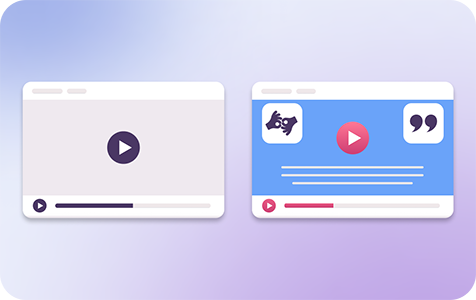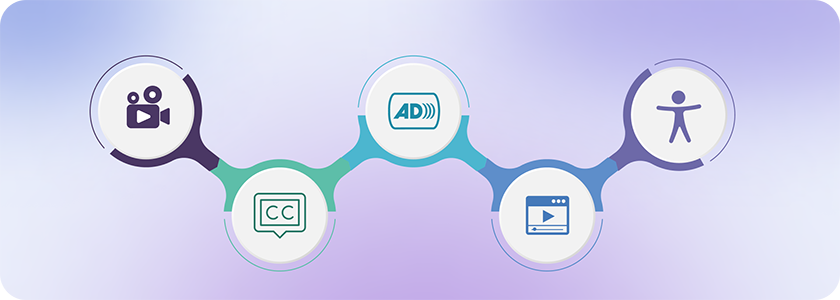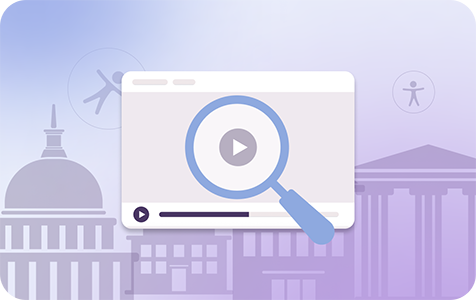Inclusive Media: Understanding Video Accessibility for Business
Navigating the Digital Video Revolution
In today's digital domain, video is a powerhouse: a scalable way for businesses to communicate with their customers, employees, and partners. It's used for everything from marketing showcases to hands-on tutorials. However, not everyone can easily access and enjoy video content. People with disabilities such as deafness, blindness, or low vision are likely to have difficulty understanding or participating in videos that do not have accessibility features.
As the wave of video content rises, so does the conversation around video accessibility. In business or web development, this isn't a new direction. It's an essential and growing part of the conversation.
The Continuing Evolution of Inclusive Media
The digital age promised us all a super-connected world, like nothing ever seen before. But as it unfolded into reality, it became increasingly evident that connectivity had to be more than just linking points A and B. Every individual, regardless of their abilities, should be able to fully participate in this vast digital tapestry.
The concept of what content accessibility should be has evolved over time. In the early days of the internet, accessibility was often overlooked. However, as more people with disabilities began using the internet, the need for accessible content became clear.
In the late 1990s, the World Wide Web Consortium (W3C) developed the Web Content Accessibility Guidelines (WCAG). The WCAG are a set of guidelines that help web developers create accessible content. The WCAG are updated regularly to reflect new technologies and best practices.
In addition to the WCAG, there are other regulations and standards that businesses should be aware of when creating accessible content. These include the Americans with Disabilities Act (ADA), Section 508 of the Rehabilitation Act, and the European Accessibility Act.
The Benefits of Making Business Videos Accessible
Businesses thrive when they communicate effectively. By embracing video accessibility, companies can tap into a broader and more diverse audience.
Accessibility fosters inclusivity, but it also gives a boost to SEO (Search Engine Optimization). And there's the legal aspect. Sticking to video accessibility guidelines keeps businesses compliant, sidestepping potential legal challenges and looming financial damages.
Making your business videos accessible will:
Help you reach a wider audience: By making videos accessible, businesses can reach a wider audience, including people with disabilities.
Boost your SEO: Accessible videos are more likely to be indexed by search engines, which can help businesses improve their search engine ranking.
Get you compliant with regulations: Businesses that operate in many jurisdictions may be required to make their videos accessible in order to comply with regulations.

Making Corporate More Accessible
Video content is not just about marketing. In the corporate world, from training modules to video conferencing, accessibility tools play a pivotal role. Videos are used in many different ways in a corporate setting, from training to marketing to customer service. If the aim is to create a cohesive work environment, making sure all videos are accessible is not just a good move, it's vital. This approach guarantees that everyone, regardless of their abilities, gets the same message.
For example, a company that provides training videos for its employees should make sure that the videos are captioned and have transcripts so that deaf and hard of hearing employees can understand the content. A company that uses videos to market its products or services should make sure that the videos are accessible to people with low vision so that they can see the visuals. And a company that uses videos to provide customer service should make sure that the videos are accessible to people with cognitive disabilities so that they can understand the information.
Creating Accessible Videos: A Few How-Tos
Accessible videos aren't just traditional videos with captions slapped on. It's a more comprehensive approach. Captions are crucial, but so are transcripts for those who prefer reading or can't access audio. The more accessibility you add, the more people you’re inviting to watch your videos.
Here are some of the many different methods that can be used to make videos accessible:
Captions
Text that is displayed below the video to provide a visual representation of the audio.
Note: The automatic captions provided by video services are in many cases of rather poor quality. This is because the audio can’t always be understood very well by the automatic captioning software. This can happen because of background noise, different accents, or speakers switching back and forth. In some cases, these automated captions are not considered accessible at all.
Transcripts
Written versions of the audio in the video. Again, these are often at a different quality and accessibility level when they’re manually transcribed rather than automatically filled in.
Audio descriptions
Narrations that provide descriptions of the visual content of the video.
Accessible video players
These allow users to control the video playback, for example adjusting the speed or the volume.

Tools and Services to Support Video Accessibility
There are many tools and services available to help create accessible video content. You’re not the first one to deal with this issue. You’ll find a wealth of accessibility resources waiting to be explored, including:
Captioning services
There are many options that automatically generate captions for videos: take your pick. Depending on the complexity of your video caption needs, as well as your specific legal requirements, you may want to consider hiring a captionist. If that’s in your budget, it usually results in a more accessible video.
Video transcription services
Similarly to captioning services, these services can create written transcripts of videos. Whether you choose an automated transcription option or request a transcript from a team member or outside professional is up to you.
Audio description services
Once again, there are automated and manual versions of this. These services create audio descriptions for videos.
Accessible video players
This should be one of the simpler choices you have to make. There are quite a number of accessible video players available to play back videos.
Is Your Business Video Ready for Its Close-Up?
Businesses are coming under scrutiny from government regulators and accessibility advocates for their use of inaccessible video content. The spotlight on businesses isn't just from customers or partners anymore. Government regulators and accessibility advocates are now part of the audience, watching intently. They're on the lookout for problems in video content accessibility that might leave some viewers out of the picture.
This closer observation is not intended to trip up businesses, but rather to move the digital state of affairs forward so everyone benefits. The attention is actually a win-win. Although it may mean some pressure for businesses, meeting these standards not only sidesteps potential legal challenges but also presents their business message and identity to a broader audience. Today, an accessible video isn't just a regulatory checked box, it's a statement of a brand's ethos and commitment to inclusivity.
United States
In the United States, the Americans with Disabilities Act (ADA) requires businesses to make their websites and other online content accessible to people with disabilities. This includes video content.
Europe
In the European Union, the European Accessibility Act (EAA) sets similar requirements for businesses that operate in the EU. The EAA requires businesses to make their websites, apps, and other digital services accessible to people with disabilities.
In addition to legal requirements, businesses may also face reputational damage if they are found to be using inaccessible video content. Customers and employees with disabilities may be less likely to do business with a company that does not make its video content accessible.
If you’re a business owner, it’s important to make sure that your video content is accessible. There are a number of things you can do to make your videos accessible, such as adding captions, transcripts, and audio descriptions, as mentioned above. There are also a number of tools and services available that can help you make your videos accessible, including the ones we’ve already listed for you.
By taking the time to make your video content accessible, you’re looking after your video users, making sure everyone can enjoy your content, regardless of their abilities. You’re also protecting your business from legal liability and reputational damage.
If your business is aiming for the spotlight, the question is simple: Are your videos ready for everyone to enjoy? If not, now's the perfect time for a retake.

Video Accessibility: Play it Forward
Everyone deserves a front-row seat at the digital show, and video accessibility presents that. By using the many methods and tools available to make videos accessible, businesses take everyone into account. That has genuine impact as well as rich rewards. Delivering accessible video content not only expands business reach, it helps build a more inclusive digital landscape and a more welcoming environment for everyone.









